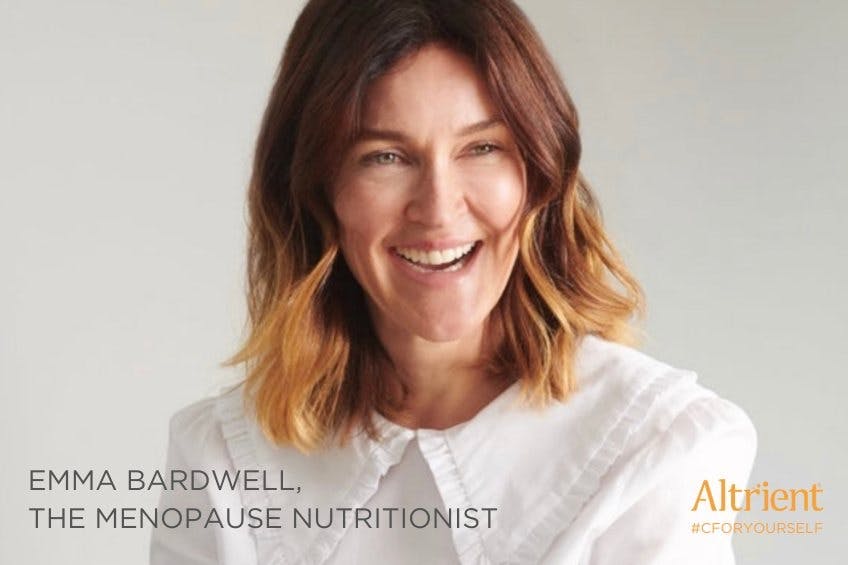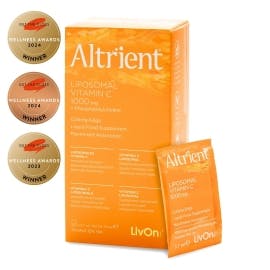Spotlight on vitamin C and its role in perimenopause
Perimenopause - the transition into menopause - often brings a raft of physiological changes, from the poster symptoms such as hot flushes and night sweats, through to lesser-known conditions like dry skin, heart palpitations and joint pain. Add insomnia, anxiety and low mood into the mix and you have a rather challenging line-up of physical and mental hurdles to overcome.
Buckle up
Taking into account the fact that many healthcare professionals are not trained enough in recognising menopause, women are often floundering by the time I see them in the clinic. Menopause isn’t a disease, it’s a fact of life, but that’s not to say it’s an easy ride. Thankfully, whether you choose to manage your symptoms via pharmaceuticals or not, there are some very beneficial diet and lifestyle measures you can put in place to power you through this seismic change, and beyond.
Get the basics right
As a nutritionist, it would be remiss of me not to remind you of the importance of a balanced diet with plenty of plant-based foods, some healthy fats and lots of colour and diversity. You need to think about your calcium intake (700mg daily if you’re under 50, 1200 mg if you’re over), take care of your gut (think fibre and fermented foods) and ensure you’re getting 150 minutes of moderate exercise a week, ideally alongside a couple of strength-based workouts. It’s also worth cutting down on alcohol as it can play havoc with hot flushes, sleep, anxiety and think about reducing saturated fat; with women over 50 nine times more at risk of heart attacks than breast cancer, midlife needs to be very much focused on cardiovascular health.
All change
When it comes down to the nitty gritty of your dietary needs during perimenopause, vitamin C (also known as ascorbic acid) can be extremely beneficial. It’s important throughout our lives - as a powerful antioxidant, as well as a cell protector and immunity supporter - but it can be especially important during perimenopause when we’re often floored by symptoms, are having trouble sleeping and stress levels are soaring. We know that vitamin C levels levels drop steadily as women progress through the menopausal transition(1) though we don’t know exactly why. One hypothesis is that a perimenopausal body is undergoing quite a few physical changes - as well as dealing with lots of stressors - and vitamin C is essential for growth, repair, recovery and adrenal support.
Support act
Collagen is the most abundant protein in our body, making up the connective tissues that provide support, structure and protection in the body. Collagen keeps ligaments and tendons in joints strong, it gives our pelvic floor ‘bounce’ and is a vital component of skin, making it stretchy and plump. As we move into perimenopause, oestrogen levels begin to deplete and many women find their skin becomes dryer as they produce less oil in sebaceous glands and the skin loses its ability to hold onto water. In fact, according to the American Academy of Dermatology, we experience a 30 percent drop in collagen in the first five years of menopause(2). Vitamin C is crucial for healthy collagen and hyaluronic acid production(3)) so if you’re low in this vitamin your body won’t be able to create adequate levels. Making up the deficit, through diet or supplementation, can be helpful for joint, vaginal and skin health. Some studies have also found vitamin C may help with healing tendon and ligament injuries(4) and many more link high intakes of vitamin C with better skin quality, while lower intakes are associated with a 10% increased risk of developing dry, wrinkled skin(5).
Bones and brains
Rather staggeringly, 1 in 2 women after the age of 50 will experience a fracture, usually as a result of low bone strength(6). Vitamin C - together with calcium, magnesium, zinc and vitamins D, E and K - plays a critical role in bone health and the prevention of osteoporosis. In 2018, a study of menopausal women in Korea positively associated vitamin C with higher bone density (7) and it has also been indicated in another paper for improving cognitive function in post menopausal women, especially when it came to verbal recall (8). Don’t forget the importance of exercise for bones and brains too. Brains physically shrink one percent a year after the age of 40, but regular exercise - anything that gets the blood pumping - can not only halt this but reverse it, increasing brain mass by two percent a year when carried out regularly. Weight bearing activities like walking, skipping, jogging, lifting weights, dancing and tennis are all good examples for building up bone matrix.
Heart happy
Cardiovascular disease - heart attack, stroke, angina - is the leading cause of death in women over 50 in the UK. In fact a menopausal woman is nine times more likely to die of a heart attack than breast cancer. Vitamin C is needed to strengthen and keep blood vessels healthy, which is really important in perimenopause as circulation deteriorates significantly. Monitor your cholesterol, blood pressure, blood sugar levels and weight to lower your risk of heart disease. If you’re not already, try incorporating plenty of omega 3 into your diet: oily fish such as salmon and mackerel are the best sources, as well as chia seeds, walnuts and flax.
Teeth and gums
Vitamin C is essential for gum health and teeth repair. Bleeding gums, receding gums and tooth movement are quite common in perimenopause, as are oral changes such as altered taste, dry mouth, burning mouth syndrome and a greater sensitivity to hot and cold foods. Rather worryingly, gum disease can increase the risk of other serious illnesses such as cardiovascular disease, chronic kidney disease, and rheumatoid arthritis as bacteria under the gums can pass into the bloodstream, affecting other parts of the body.
High histamine
Interestingly, vitamin C is a natural antihistamine - it works by calming down mast cells that are responsible for producing histamine in the first place. So if you suffer from high histamine levels, vitamin C might help to mitigate symptoms. Signs that you might have this condition are: itchy skin, headaches, sinus problems, runny nose, fatigue and digestive issues. Histamine intolerance often goes undiagnosed; it can be as a direct result of too many histamine producing foods (alcohol, yoghurt, shellfish, processed meats, avocados, aubergine, bananas, tomatoes), or sometimes because of a genetic polymorphism that means you don’t produce DAO which breaks histamine down. There’s also a strong hormone connection with histamine intolerance, so many women find the onset of perimenopause sets off symptoms and causes all sorts of allergies that they never experienced when younger.
How to get enough?
The best way to get vitamin C is through your diet. Exposure to light, heat and oxygen can decrease the amount of vitamin C in fresh fruits and vegetables so eat them soon after buying and always steam where possible to retain their nutrient status. Vitamin C big hitters include red peppers, oranges, kiwi fruit, mango, tomatoes, berries, broccoli, green leafy veg, parsley, potatoes, frozen peas, blackcurrants and mangos.
Things to consider
Environmental factors affecting quality of life at the time of perimenopause may adversely influence the diet and, as a result, vitamin and nutrient levels. Factors that may have a potentially detrimental impact include being time poor, stressed and tired, having problems with family life or a reduced appetite, and suffering from poor gut health and changes in eating habits. It’s worth noting that the adrenal glands, which take over oestrogen, progesterone and testosterone production when the ovaries start shutting down, require vitamin C to stay healthy. The adrenals also produce cortisol in response to stress, so the more cortisol that’s made to cope with frantic life demands, the higher the body’s requirement for vitamin C. We all know how testing this life stage can be. If you’re concerned that your lifestyle is impacting your ability to reach optimal vitamin C levels or you might not be absorbing nutrients well due to digestive dysfunction then supplementing with a good quality brand such as Altrient’s Liposomal Vitamin C might be beneficial (always talk to a healthcare professional before embarking on a new supplement regimen).
Embrace the journey
Understanding the changes that happen during perimenopause is incredibly empowering. Our bodies are remarkable, but they need the right fuel and support. Wherever you are on the journey, know you’re not alone and there is plenty of help on hand.
Emma Bardwell
The Menopause Nutritionist
https://www.emmabardwell.com
References
Wiacek M et al. (2013). Menopause and age-driven changes in blood level of fat- and water-soluble vitamins. Climacteric : the journal of the International Menopause Society.16(6):689-99.
American Academy of Dermatology (2019) Caring for your skin in menopause. www.aad.org/public/skin-hair-nails/skin-care/skin-care-during-menopause.
Kishimoto et al. (2013). Ascorbic acid enhances the expression of type 1 and type 4 collagen and SVCT2 in cultured human skin fibroblasts.
Cosgrove M et al. (2007). Dietary nutrient intakes and skin-aging appearance among middle-aged American women. American Journal Clinical Nutrition. 86(4):1225-3
DePhillipo et al. (2018) Efficacy of Vitamin C supplementation on collagen synthesis and oxidative stress after musculoskeletal injuries: a systematic review.
Age UK (2019) Osteoporosis. www.ageuk.org.uk/information-advice/health-wellbeing/conditions-ilnesses/osteoporosis
Kim Ya et al. (2015) “Favorable effect of dietary vitamin C on bone mineral density in postmenopausal women. Osteoporos International. 2015 Sep; 26(9):2329-37.
Vijayakumar TM et al. (2017). Comparative assessment of methylcobalamin and ascorbic acid on cognitive function in post-menopausal women - A randomized, double-blind trial. Contemporary Clinical Trials Communication. 8:175-180.
McCabe D et al. (2017). The impact of essential fatty acid, B vitamins, vitamin C, magnesium and zinc supplementation on stress levels in women: a systematic review. JBI database of systematic reviews and implementation reports. 15(2):402-53.


.jpg?auto=format&q=45&w=262&trim=auto)

